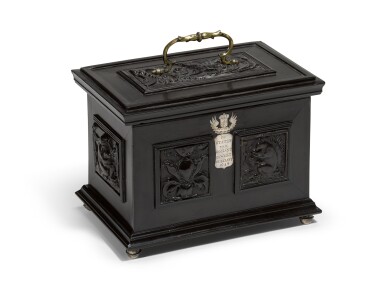Furniture, Silver, Clocks & Ceramics
Furniture, Silver, Clocks & Ceramics

A Dutch ebony and pressed baleen casket, Amsterdam, mid-17th century
Lot Closed
May 17, 11:17 AM GMT
Estimate
10,000 - 15,000 GBP
Lot Details
Description
A Dutch ebony and pressed baleen casket, Amsterdam, mid-17th century
the panelled and moulded casket veneered on oak, the hinged lid with brass carrying handle and hinges, the front mounted with a later silver armorial mount with engraved text De Staten van Holland en West Vriesland 1648 between two raised decorative panels, the lid, sides and back each with one panel, all panels inset with ebonised pressed baleen plaques in ‘kwab’ style depicting a putto with dolphins, a flower or various animals within foliage, the right side with a sliding panel enclosing a small hidden drawer
14cm. high, 17.8cm. wide, 12cm. deep, 5½in., 7in., 4¾in.
RELATED LITERATURE
Baarsen, R. Nederlandse Meubelen 1600-1800, Amsterdam, 1993, pp. 36-39.
Baarsen, R. Herman Doomer en de Amsterdamse ebbenhoutwerkers, in: Wonen in de Gouden Eeuw, Amsterdam, 2007, pp. 80-109.
Van Thiel, P., Kops Bruyn, Johannes Cornelis, Framing in the Golden Age: Picture and Frame in 17th-century Holland, Rijksmuseum Amsterdam, 1995.
Breebaart, I., G. van Gerwen, Pressed baleen and fan-shaped ripple mouldings by Herman Doomer, in: Eleventh international Symposium on Wood and Furniture Conservation, Amsterdam 9-10 November 2012, pp. 62-74.
This fascinating casket is a rare example of the use of pressed baleen work, a quintessential Dutch Golden Age technique. The Dutch develop a profitable fishing trade of Greenland right whale, used for its fat that could be turned into oil. Baleen are the fringed plates hanging in right whales' mouths used to strain seawater for food and the Dutch quickly realized this by-product could have a use.
The Englishman John Osborn, an ivory and horn worker active in Amsterdam, was the first to have a patent to prepare baleen in 1618 and, 23 years later, the celebrated cabinet-maker Herman Doomer and his son Matheus were also granted a pattern to press this material.
Baleen’s dark colour and polished sheen were a perfect match for ebony, which since the early 17th century was becoming widely available in Amsterdam through the expansion of the Dutch Indies Company (VOC) activities, resulting in luxury pieces of furniture and objects.
The present lot hence demonstrates this fine pairing with ebony veneers and mouldings framing six small sections of pressed baleen; with motif choice quite aleatory – squirrel, a putto with dolphins, a flower or various animals within foliage – which somehow reveal its scarcity and how prized these were.
One other comparable casket, with similar dimensions and configuration, was sold from Ashdown House, Sotheby’s London, 27 October 2010, lot 137 (published Breebart and van Gerven, p.65, fig.11).
Interestingly, a mirror frame attributed to Herman Doomer (c.1640-1655) in the Rijksmuseum collections (BK1978-188) has a pressed baleen inner border with some of the motifs seen in the present lot, copied from prints after kwab designs by Hans Janssen. Although it is likely that several copies were made from the same mould, it seems also that “it was very time-consuming to prepare the baleen and to produce the moulds. This may explain the limited amount of objects which are known to be made from pressed baleen (Breebaart and van Gerwen, p.72)
